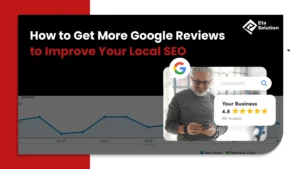
E-Commerce Web Design Trends to Keep You Ahead in 2025
Latest eCommerce Website Trends That Will Transform User Experience
Have you visited Amazon and Apple’s websites? What do they all have in common? A flawless, conversion-driven website. These giants don’t just rely on their reputation; they invest heavily in interactive web design to maximize sales and customer retention.
Now, look at your eCommerce store competing with that. You’re already falling behind in the digital game if your website doesn’t follow current design trends.
According to a Blue Corona study, 75% of customers base their opinion of a company’s credibility solely on the appearance of its website. And I find it very true, Because we all do this before placing any order, right? That means a poor design can cost you customers before they even explore your products. In 2025, it’s not just about aesthetics; It is more about your website’s layout, speed, and user experience. These elements directly impact conversion rates and brand perception.
Businesses are using an Ecommerce Marketing Company that specializes in advanced web design to stay competitive. Here is what you need to know if you also want to use your website’s power to dominate the market in 2025.
Example of Web Design for E-Commerce Website

Why Is It Important to Keep Up with Design Trends?
Would you put your trust in a store with dusty shelves, old lights, and an unclear layout? Most likely not. Your online store is no different. Visitors will abandon your website before they have had a chance to look at your products if it feels antiquated, sluggish, or awkward.
Because it keeps customers interested and encourages them to make a purchase, you must stay up to date with eCommerce web design trends 2025. Here’s why staying updated is so important:
- First Impressions Matter – 94% of first impressions are based on website design. It affects your brand’s credibility.
- SEO & Mobile Optimization – Google favors fast, mobile-friendly websites. So make sure your website is fully SEO optimized to improve search rankings.
- Higher Conversion Rates – A sleek, conversion-focused eCommerce design can eCommerce design can increase sales by 35% or more.
- Competitive Advantage – Web design for online stores builds trust and reduces bounce rates. Not only this, an updated website keeps customers engaged.
Now, let’s dive into the latest eCommerce website trends for 2025 and how you can use them for success.
Top E-Commerce Web Design Trends in 2025

1. AI-Powered Personalization: The Future of Smart Shopping
AI-driven E-Commerce web design is revolutionizing customer experiences. With AI in eCommerce web design, brands now can:
- Analyze user behavior to show personalized product recommendations.
- Offer dynamic pricing based on real-time demand.
- Improve chatbot interactions so that response time and support get improved.
Nike’s website uses AI-powered personalization to recommend shoes based on browsing history and past purchases. This personalized experience has more chances of boosting user conversions.
2. Mobile-First eCommerce Design: The New Standard
With 72% of eCommerce sales happening on mobile, brands must optimize for smaller screens. If you are optimizing your websites for mobiles, then keep these points as priorities:
- Thumb-friendly navigation for easy scrolling and interactions.
- Progressive Web Apps for an app-like shopping experience without downloads.
- Blazing-fast load speeds because a 1-second delay in load time reduces conversions by 7%.
ASOS saw a 20% increase in conversions after switching to a mobile-first eCommerce design.
3. Minimalist, Distraction-Free UI: Less Is More
Consumers get confused by cluttered pages. You will lose big if you don’t lead your users to the next action. The modern eCommerce UI/UX focuses on:
- Fewer elements on product pages. It enhances focus.
- More whitespace. It makes information easier to digest.
- Engaging micro-interactions such as subtle animations guide users to the ultimate action, like subscribing, buying, or clicking.
Apple’s website remains one of the best examples of clean, conversion-focused eCommerce design.
4. Augmented Reality & 3D Visualization: Bringing Products to Life
With AR and 3D models, customers can experience products virtually before buying. Brands that use AR on their websites can see:
- 40% higher conversion rates compared to traditional product pages.
- Fewer returns due to better product visualization.
IKEA’s AR app lets users see furniture in their homes before purchasing. It is like physical store shopping.
5. Dark Mode & Customizable Themes: Better UX, Less Eye Strain
Dark mode has become more than just a trend. Nowadays, it’s a necessity. Dark mode has become more than just a trend—it’s now a necessity. As people become more screen-conscious, best UX practices for eCommerce focus on some factors. Blogging and news websites, where people tend to spend more time, need to follow these latest eCommerce website trends:
- User-selectable themes for better personalization.
- Lower energy consumption on OLED screens.
- Improved contrast, making products stand out.
Spotify and Twitter have successfully integrated dark mode to improve user experience.
6. Voice Search Optimization: The Rise of Hands-Free Shopping
By the end of 2025, 50% of online searches will be voice-based. The future of eCommerce design includes:
- Brands are optimizing their website content for conversational queries rather than just keywords.
- Industry-leading brands are implementing voice-assisted shopping features.
- They are focusing on site speed for instant voice-based results.
Walmart’s partnership with Google Assistant allows users to add items to their carts via voice commands.
7. Sustainability in Web Design: The Rise of Green Commerce
Eco-conscious consumers are influencing eCommerce website design inspiration. Brands are:
- Green hosting solutions to reduce carbon footprints.
- Minimalist product pages with optimized file sizes to consume less data.
- Sustainable packaging and messaging integrated into the UI.
8. Gamification: Turning Shopping into an Experience
Interactive shopping experiences increase engagement and conversions. What top strategies can you include?
- Spin-to-win discounts on checkout pages.
- Personalized quizzes to suggest products.
- Reward-based loyalty programs for repeat customers.
9. One-Page Checkout: Simplify the Buying Process
Shoppers, including you, hate long, complicated checkout processes. So, UX designers include these tactics in e-commerce websites.
- One-page checkouts that reduce friction.
- Auto-filled payment details for faster transactions.
- More payment options like crypto, digital wallets or BNPL services.
If you have noticed Amazon’s one-click checkout, you will get the answer to why people prefer Amazon over any other shopping store.
10. Humanized Microcopy & Conversational UX
Traditional product descriptions are outdated. Websites are now using:
- Conversational microcopy to engage users.
- Personalized recommendations that feel less robotic.
- Use fun, engaging error messages so that people notice you and think of coming back again.
Have you seen Mailchimp’s playful microcopy? You should. It makes marketing automation feel human.
How to Choose the Best Ecommerce Design for Your Website
To implement these latest eCommerce website trends, follow these steps:
- Know Your Audience – Understand customer preferences and buying behavior.
- Partner with an Expert – An Ecommerce Marketing Company makes designs that can get you better conversions and user engagement.
- Prioritize Speed & Mobile UX – Make sure your website performance is smooth across all the devices.
- Maintain Brand Consistency – A unified experience builds trust and loyalty.
- Test & Optimize Continuously – A/B testing is a must if you expect maximum conversion rates.
Final Take
The brands that will win in 2025 will be the ones that prioritize innovation, modern eCommerce UI/UX, and smooth design. A well-optimized eCommerce website isn’t just about aesthetics. Your website elevates your brand above the competition, increases conversions, and fosters trust.
Customers demand speed, efficiency, and personalization in the rapidly changing digital landscape. If your website doesn’t deliver this, then they’ll definitely find the other option.
Now is the time to future-proof your online store. Adapt and execute the latest trends, refine your UX, and create a shopping experience that keeps customers coming back. Make sure your business implements E-commerce web design trends 2025 to mark your name into upcoming success stories.
E-commerce web design is the process of creating a website where people can buy and sell products or services online. It focuses on making the site easy to use, visually appealing, and safe for shopping. A good e-commerce design helps customers find products, view details, add them to a cart, and make payments smoothly. For example, Amazon has a simple and user-friendly design that lets people search for items, read reviews, and order with just a few clicks.
A good design for an e-commerce website is clean, simple, and easy to navigate. It should load fast, work well on phones and computers, and make it easy for customers to find products, read details, and check out quickly. Clear product photos, short descriptions, visible prices, and a smooth shopping cart and payment process are all important. For example, websites like Nike or Zara use large images, easy menus, and a simple checkout to give customers a great shopping experience.
There isn’t one single “best” eCommerce website, but some of the most successful and well-known examples include:
Amazon – It’s the biggest eCommerce site in the world, known for its huge product range, fast delivery, and easy checkout.
Shopify – Not a store itself, but a platform that powers millions of online shops with great design and features.
eBay – Popular for auctions and second-hand goods, with a trusted payment system.
Walmart – Offers both online and in-store shopping with competitive pricing.
Apple – Known for its clean design, smooth user experience, and strong brand identity.
Mobile-first design means creating your website with smartphones in mind first, then adapting it for larger screens. This approach is super important for online stores because most shoppers now use their phones to browse and buy. A mobile-first design ensures your site loads fast, is easy to use with fingers, and displays products clearly on small screens. This leads to a better shopping experience, higher customer satisfaction, and more sales. If your site isn’t mobile-friendly, you risk losing customers to competitors who are.

What started as a passion for marketing years ago turned into a purposeful journey of helping businesses communicate in a way that truly connects. I’m Heta Dave, the Founder & CEO of Eta Marketing Solution! With a sharp focus on strategy and human-first marketing, I closely work with brands to help them stand out of the crowd and create something that lasts, not just in visibility, but in impact!





